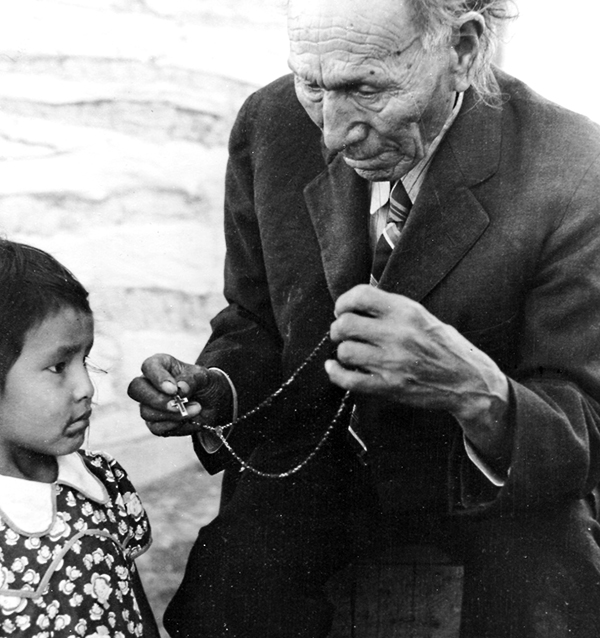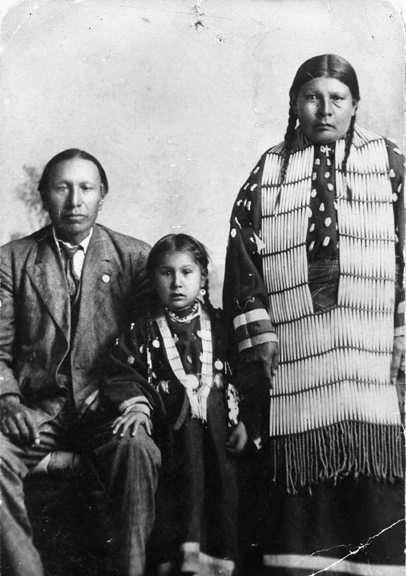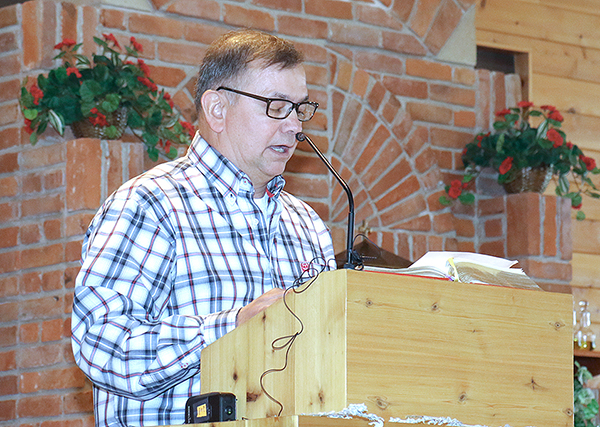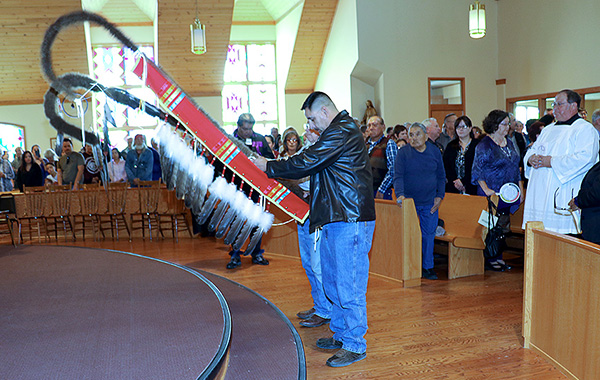|

People from around the world know of the famous book “Black Elk Speaks.” Published in 1932, it recounts the stories and spiritual teachings of Nicholas Black Elk (1863-1950), a revered holy man among the Oglala Lakota.
What is less well known is that Black Elk was also a leader right here at Red Cloud, as a part of the parish community that continues to celebrate his memory and keep his voice alive today.
During the second half of his life, Nicholas Black Elk become a practicing Catholic—and then ultimately a catechist or religious teacher—sharing with others his conviction in the parallels between Lakota and Catholic spirituality. Black Elk’s grandson George Looks Twice, who lived with his grandfather when he was a teenager, remembers how he drew on both traditions in practicing his own faith, praying with a rosary and also with a pipe.
“People would come to ask him to pray with them,” said Looks Twice. “He was a man of God.”
To honor the gifts that he brought to his community and to the Church itself, last year the Diocese of Rapid City formally nominated Black Elk for canonization—the process of becoming a saint. Now parishioners from across the reservation are reflecting on his legacy and what his sainthood would mean for Native Catholics.
Few are closer to that process than Bill White, the pastoral coordinator at Christ the King Church in Porcupine, who was named a postulator, and so will present the case for Black Elk’s canonization to the Church. For him, Black Elk’s sainthood would reinforce something that he has experienced in his own life—the weaving together Catholic and Lakota spiritual traditions.
“I was brought up a Catholic, and my Lakota spirituality came later on,” said White. “It’s similar to something Nicholas Black Elk’s own son Ben said—that growing up, he thought he had two lives, one rooted in the Catholic religion, and the other in Lakota beliefs. But that the older he got, the more they merged into one. That’s what Black Elk brings to us. He brings both religions together—you can be Lakota and be Catholic too.”

Nicholas Black Elk and Family
Before he was even ten years old, Black Elk received a vision that transported him spiritually to the highest point in the sacred Black Hills, on what is now known as Black Elk Peak. Of that moment, he said that:
"I was standing on the highest mountain of them all, and round about beneath me was the whole hoop of the world. And while I stood there I saw more than I can tell and I understood more than I saw; for I was seeing in a sacred manner the shapes of all things in the spirit, and the shape of all shapes as they must live together like one being.”
That vision of unity, says White, continued to guide him through the rest of his life.
“The dream or vision he had when he was 8 years old…basically said that we must all live together as one, and that’s exactly what Jesus wanted—for us to love one another. And that shaped his life.”
Black Elk’s journey reflects his constant search for spiritual truth—and the desire to bring about the unity he recognized in his vision. As a Lakota holy man, he offered guidance and healing as his people and other tribal nations fought fiercely against the U.S. government to maintain their homelands and way of life. As the reservation era began and he came to know the Jesuits at Red Cloud—then Holy Rosary Mission—he began studying Christianity, his spiritual searching continued. In 1904 he was baptized, selecting the name “Nicholas” to honor Saint Nicholas, known for his humility and commitment to serving the poor. He spent the rest of his life working tirelessly to share what he had learned—serving in the parish and traveling thousands of miles across state lines to offer peace and reconciliation.
Now, Black Elk may be named a saint for choosing to live his life in that way. But for Bill White, that recognition would honor more than just Black Elk himself. It would honor the voices of indigenous Catholics around the world and deepen understanding of their contributions.
“I would hope that, within the Church itself, this would bring indigenous voices to light,” said White. “And help non-natives see that we have sacred people in our culture—to increase that understanding.”

Bill White at Black Elk's Mass
To celebrate the sacredness of Black Elk’s life, and to mark the beginning of his canonization, a special Mass was held on Red Cloud’s campus—in the exact same place where his spiritual journey in the Church began. In the months since then, Bill White and many others working toward his canonization have continued to gather evidence to support the cause of Black Elk’s sainthood.

Black Elk's Mass at Red Cloud
It will take years, explains White. But even this early in the process, the journey is filled with hope for unity.
“Black Elk’s word that we must all live together—that’s a gift he’s already given us.”
Read More about Black Elk’s Canonization here.
|